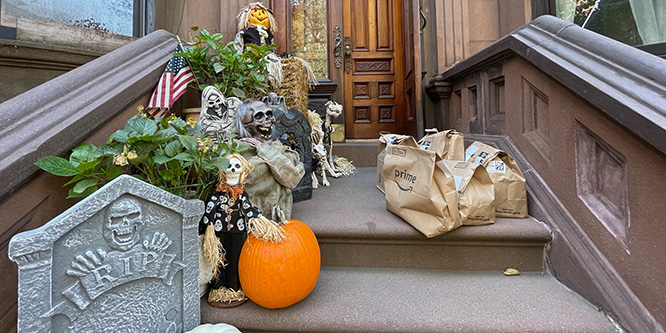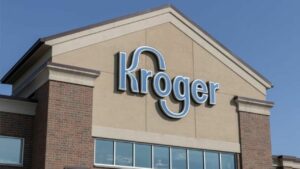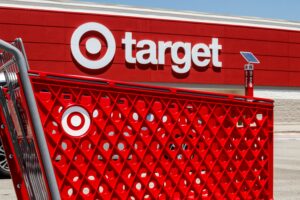
Photo: RetailWire
October 31, 2022
What are the biggest emerging threats facing online delivery?
The “Annual State of Shipping Study” from UPS Capital, UPS’s insurance division, finds porch piracy, fraud and climate-related issues to be the top emerging threats facing online delivery.
On those threats, the survey of 500 merchants and 1,000 online shoppers across the U.S. found:
- Porch piracy: Two-in-five merchants stated that porch piracy has become more of an issue for their business in 2022 than in previous years. Almost a third (32 percent) reported financial losses of more than $50,000 due to porch piracy in the last year. Among shoppers, 44 percent experienced porch piracy last holiday season, and households with children were twice as likely to experience porch piracy compared to childless households.
- Fraud: Thirty-seven percent of merchants reported that credit card fraud is a growing risk to their business, with return shipment fraud (from missing merchandise to altered labels and return addresses) at 31 percent and false reports of stolen packages, 27 percent.
- Climate-related issues: Three-quarters of merchants experienced an increase in damaged, expired or lost packages due to climate change over the last 12 months, and 92 percent anticipate an increase in such issues due to climate change over the next five years. Among shoppers, 77 percent believe that extra steps are needed to protect their orders from weather issues.
The impacts of delivery incidents, according to merchants, included extra time spent with customers resolving their damaged or lost packages and making them whole, cited by 53 percent; financial loss due to sending a second unit, 50 percent; and negative reviews adversely affecting their business’s reputation, 37 percent.
When asked about possible solutions, 56 percent of merchants said they believe that acts of porch piracy should be taken as seriously as theft in brick-and-mortar stores.
The wide majority of merchants believe greater visibility into late shipments, lost claims, credit card fraud transactions, porch piracy claims and damaged claims would help better resolve overall delivery issues. Among the shopper respondents, 84 percent expect a replacement or refund within a week of notifying the merchant of a lost, stolen or damaged package.
On climate-related issues, potential mitigation steps include larger investment in weather stabilizing shipment packaging, faster delivery times and shipment insurance policies.
Discussion Questions
DISCUSSION QUESTIONS: Which of the three threats facing online delivery — porch piracy, fraud or climate-related issues — will be the toughest to overcome? What solutions do you see?
Poll
BrainTrust
Lisa Goller
B2B Content Strategist
Rachelle King
Retail Industry Thought Leader
Ryan Mathews
Founder, CEO, Black Monk Consulting
Recent Discussions







Combined these three threats represent a significant cost, and they’re all important. But what’s even more troubling is the impact these issues have on retailers’ profitability. Retailers can’t continue to spew money and kill their profitability all in the name of online delivery. Yes consumers love delivery services, but the cost to the environment and to the retailers themselves is making this an unsustainable, losing proposition for many retailers. There are no easy answers to solving these issues, but I think retailers like Target have the most effective playbook – encouraging in-store pick-up can significantly reduce these challenges and also improve profitability.
Amen. Home delivery is the most expensive way to get a product to a consumer. It’s not the future.
Cathy,
I totally agree with you on the economics, at least under the current model, although I do think there are workarounds on cost that could ease the pain on shippers a bit.
But, to me, the real question is, “How do you manage consumer expectations?” Once you’ve provided folks with a “service” for “free” it’s pretty hard to change the model without making lots and lots of consumers really, really, angry.
Curious if you had any ideas how that could be mitigated.
I will add a fourth: profitability. The high costs of fulfillment have always weakened e-commerce margins. However as costs – including fuel costs – have risen, this has worsened. There are some segments, such as ultra quick delivery, which mostly have business models that are unsustainable. This is something more retailers are now waking up to hence some of the pivots: charging for returns, making free delivery part of paid membership options, using stores more effectively, and so forth. Going forward there needs to be much more realism around the costs of online delivery.
Very good point Neil! I agree that the high cost of fulfillment is the biggest threat to online delivery profitability and it is probably a bigger concern that the three issues identified in the study. Encouraging more customers to opt for store pickup is probably the best way to improve the profitability of online orders.
Agree, with inflation rising faster than wages, consumers aren’t going to pay a premium for delivery, and the retailers have to deal with high costs of labor which is the last mile to get the goods to the door. Something is going to have to give on this model as the economy slows.
The biggest threat to me is the reliance on “Big Delivery” companies like FedEx and UPS and their whims of supply chain and fuel costs. That’s what makes Amazon’s move into their own vertical delivery mechanism (planes and trucks) all the bigger and more important in terms of being able to keep that convenience promise to the consumer and blast the competition.
The difference is that with Amazon they are providing a service to THEIR customers. We can’t say the same for UPS and FedEx.
Fraud is likely to have the largest negative impact for online sellers; a significant percentage of porch piracy and weather-related claims can be included in that category as well.
How about reconciling all of the above with speed and fee structure? So many moving parts and incremental costs and so much resistance to paying nominal fees.
The industry needs and can justify implementing a fair and nominal fee structure.
Great points, Jeff.
Clever people can develop solutions to the porch piracy and climate-related issues. But no matter what rules or organization are developed there will always be a subset of humanity that will try to cheat the system.
Porch piracy is the biggest threat facing online delivery. These deliveries are an easy mark for pirates roaming neighborhoods for their booty. They have no fear of getting caught and the penalties are minor. Maybe it’s time for law enforcement to make them walk the plank.
Another solution: Tighter delivery windows would help address porch piracy and weather-damaged deliveries. If a shopper can be on the lookout for deliveries, there’s less time for exposure. RFID technology, specifically serialized SKU inventory, could help, too. A middle-range RFID reader could detect a tag at someone’s doorstep. That might help with the porch piracy problem, and serialized tags have already been proven to help identify phony returns.
Sadly, porch piracy, fraud and weather-related issues will likely get worse due to economic, cyber and climate risks. Visibility, security and verification offer solutions.
Porch piracy will drive sales of home surveillance cameras. Companies may invest in cybersecurity to protect against payment fraud. Retailers may require delivery workers’ photo proof that a package was dropped off. Similarly, retailers could ask customers to provide verification of returns, such as a photo that an item was packed. Protecting parcels inside homes and garages protects against theft and weather.
Fraud and porch piracy are the biggest two factors for online delivery, and when you couple these issues with the basic profitably equation of an online order, one can quickly see how difficult it is for retailers to maintain, never mind grow, profits. Retailers need to revisit their business models at the whiteboard, dissect every cost and come up with new, viable, long-term equations.
I would classify all of them as equally damaging. Delivery to a porch without a recipient signature is asking for trouble. Credit card fraud is being addressed with better security algorithms. Damage to packages fits in the same category as porch piracy. Don’t leave the packages exposed.
Porch piracy is certainly an issue today. Such tools as Amazon lockers and UPS stores solve some of those problems. But the problem as a whole will be solved with the development of secure drop-offs at people’s homes through technology. RetailWire discussions have addressed secure drop-off options several times. This is a solvable problem as people adapt to and engage with solutions provided by retailers/delivery services.
The fraud issue is astounding to me. As described, there seem to be lots of talent and creativity producing the fraud. It is one of those issues that as one solution is developed, the fraudsters create their solutions to counter the fixes.
Climate-change issues? The challenges will not disappear soon, if at all. Just like cities, the solutions on the delivery side will be extraordinarily expensive.
Fraud is likely the largest and most difficult to overcome. Added online security not only has difficulty keeping pace with hackers, but can often add layers of friction to the consumer experience so it has to be implemented thoughtfully. Consumer confidence and security is paramount, but there can be a trade off for convenience — which is the core of online shopping.
Like other BrainTrusters, I think there are two other factors that need to be considered — profitability and the tyranny of ever increasing consumer expectations for “instant” delivery. That said, sadly I don’t see people getting any more honest so porch pirates and scammers will continue to be with us and I don’t see the climate getting better, especially if we keep increasing the number of delivery vehicles on the road. Even electric vehicles have to be produced in plants which pollute. Which is the greater of two evils? Probably climate change because if we don’t do something about it, all the porch pirates and scammers — and everyone else — will die off.
The “tyranny of expectations.” What a great way to express it!
Fraud tops my list, however the other two are indeed emerging threats. Climate-related issues are external forces and therefore contingencies can be considered but actions will be somewhat reactive. Whereas, fraud, porch piracy, and COSTS can and must be addressed. The delivery industry is under duress and needs reinvention today. Here are three things I’d be looking at:
Store pick-up versus porch delivery should help with weather, porch piracy, and associated costs — but convenience may suffer;
Having been a recent victim of fraud, this is top of mind for me, and I’m hopeful that forthcoming security measures will help;
RFID tagging could be one way to thwart piracy — I know it’s expensive, but may well be worth the investment.
Porch piracy is the number one concern. According to a recent study over 220 million packages are stolen each year and 64 percent of Americans have been affected. The climate one doesn’t make sense to me, it seems that as the volume of packages increase in general so do the incidents related to weather. Regarding piracy, there are numerous solutions from retailers’ and consumers’ points of view. One is more intelligent delivery windows. Why not offer evening delivery for those who work at home and incentivize grouping deliveries to one or two a week instead of multiple rush deliveries happening all day and night? Also, how might retailers and consumers work together to create a more secure delivery destination for their homes?
The most obvious one is profitability. Related to that is having customer lifetime value and channel agnostic metrics, which also incorporate the cost of returns. A simple focus on isolated order profits can point one in the wrong direction.
Porch piracy and on-time delivery will be the biggest threats facing online delivery. As deliveries increase, thefts from the front doorstep will increase until a solution is found that can be broadly applied and will be safe.
All of the above and I’ll endorse Neil Saunders’ addition of profitability which would – when coupled with the others — be consolidated into one: sustainability. The current models for home delivery are simply not sustainable though some of the challenges are absolutely self-inflicted, especially by the retailers. While the threat of Amazon is real, and that includes Prime and its delivery value proposition, merchants need to create their own value proposition that is superior and drives loyalty.
Consumers define loyalty as “a willingness to pay a premium or go out of their way” to do business with a brand. Either of these factors addresses delivery’s fundamental problems.
I would say the wrong question is being asked here: these are all candidates for second-biggest threat. The biggest has always been that (for most retailers) delivery is a money-losing practice. Of course no one seems to particularly care about that … so maybe it isn’t really a “threat” at all.
It’s almost impossible to police porch piracy. Neighbors sometimes steal from neighbors, whether it’s the Sunday paper or the Amazon Fresh delivery. By some code, if goods are left out “too long” it’s fair game.
One way to think about porch piracy is if you are not home for delivery, then someone else will be. The question is, where is the merchant at fault and how much responsibility, financially, do they have for porch bandits?
As economic uncertainty continues and consumers keep pandemic-era shifts to more digital commerce, last mile providers will need to make extra efforts to secure deliveries and manage communications on delivery timings.
Fraud is an issue that online retailers can attack. Recall recently that Wegmans cancelled its “scan & go” program due to related profitability issues associated with customer fraud/theft. However, as many Braintrust analysts pointed out, Wegmans had done little to address the ease in which customers could beat the system. Attack fraud and you lessen one profit draining factor. As for porch theft and climate related issues, encourage BOPIS, via incentives, rebates, price cuts, etc. as a way to reduce these two adverse factors that severely affect the profitability of the final mile. People still like to visit brick and mortar stores, give them the incentives to do so and you will reduce final mile costs and increase in-store profitability.
Porch piracy won’t go away with the help of door cameras thanks to brazen thieves covering their faces. But tech can play a greater role in minimizing theft going forward. Amazon and Amazon Fresh with last mile ownership provide package arrival times, and instant delivery notifications in email or text so the customer can quickly get the package before thieves. Fed Ex, UPS, DHL don’t have this fully built in, nor does it look to be their priority.
One idea where Amazon could provide additional delivery support is by upgrading functionality of their network of installed Ring cameras. Package getting dropped off, the Ring camera scans a barcode/pic, customer knows it’s at their doorstep or left at secure location. A Ring camera could even be programmed to provide instructions to a driver to leave in a certain area or hold it at a Whole Foods location.
Online delivery threats like porch piracy, online fraud, or climate-related issues cannot be completely eliminated. However one effective solution to overcome these challenges can be implementing the “BOPIS” strategy. Customers picking up their orders from stores cannot make false claims about not receiving their orders. Similarly, implementing the “BORIS” strategy will ensure that customers directly return their orders to stores, resulting in a hassle-free process for both customers and retailers. Additionally, retailers can also cross-sell and up-sell products to customers visiting their stores to pick-up or return their orders.